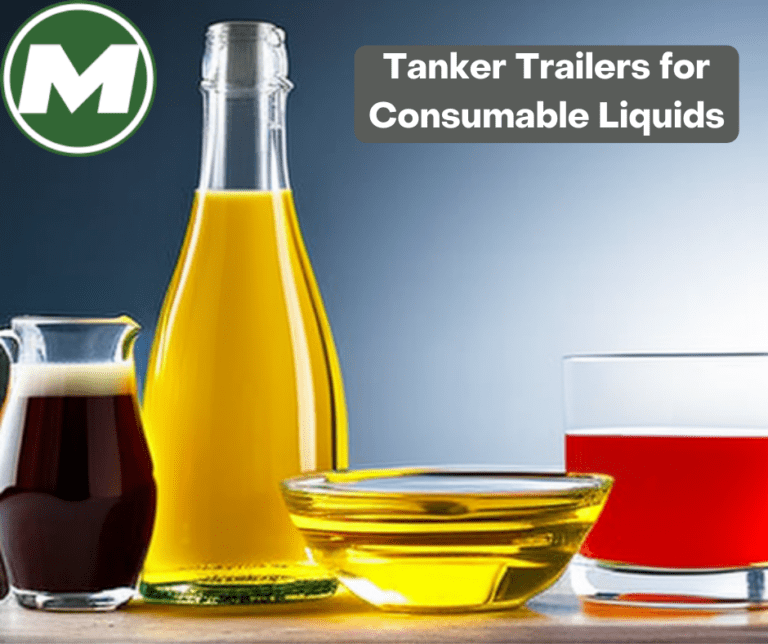According to Food Logistics, the North American logistics industry is forecasted to reach a value near the $1,200-billion mark by 2024, with a compound annual growth rate (CAGR) of nearly 5 percent. Globally, the food logistics market is expected to see an even larger growth rate (CAGR) of 8.22% during 2023 – 2028 period.
Logistics for consumable products involves planning and coordinating the flow of perishable goods from the point of origin to the point of consumption. Food grade tankers are essential for the cost-effective transportation and distribution of bulk quantities of consumable liquids to food processing plants across the country. According to Liquid Trucking, the trucking industry is responsible for over 70 percent of all food transportation in the United States.
Food grade tankers are specifically designed to meet strict sanitation and safety protocols. They are most commonly constructed from 304 stainless steel in a cylindrically shaped tank and mounted horizontally to a chassis. This particular shape is optimal for food grade tankers as it provides ease of extraction, cleaning, and sanitation. Food grade tankers can be compartmentalized to carry up to six (6) different products. They may be constructed with smooth bores, baffles, or bulkheads. Food grade tankers often include temperature control units and they must have tamper evident seals. Food grade tanks range in size from 3,000 to 11,600 gallons, but food grade tankers must remain below the Department of Transportation’s 80,000 pound limit. Additionally, some food grade tanks may be designated to specifically carry organic or kosher products.
Common Products Transported by Food Grade Tankers
A designated food grade tanker is necessary for the transport of bulk liquid food freight from its source of production to the processing plant.
A variety of liquid consumable products can be transported by food grade tankers. Examples include:
- Liquid dairy products (milk, cream, etc.)
- Fruit juices
- Vegetable, cooking and other edible oils
- Sugar-based alcohol
- Syrups and molasses
- Vinegars
- Chocolate liquor and cocoa-butters
- Liquid yeasts
- Water
Sanitization for Food Grade Tankers
In 2005 the FDA enacted the Sanitary Food Transportation Act, which applies to food grade tankers and other transportation equipment. This legislation set forth sanitary procedures for the transportation of consumable products, food products, and animal feed. The purpose of this Act was to establish and enforce standards for safe food transportation, and minimize the chance of contamination or tampering during transport.
The FDA implemented the Food Safety Modernization Act (FSMA) in 2013. The FSMA expanded the requirements for sanitary transportation stating that, “The rule establishes requirements for shippers, loaders, carriers by motor or rail vehicle, and receivers involved in transporting human and animal food to use sanitary practices to ensure the safety of that food. The requirements do not apply to transportation by ship or air because of limitations in the law.” Current sanitization procedures were derived from the FSMA. Failure to sanitize food grade tankers could potentially lead to food-borne illness and leave the carrier liable based on their negligence.
Stainless steel is the most common material used for the construction of food grade tankers. It is non-reactive and capable of undergoing the comprehensive washing and sanitizing required for transporting food grade freight. All pumps, compressors, and other associated equipment are required to be thoroughly cleaned prior to and between loads. A number of sanitization systems are available to effectively clean and keep food grade tankers on the move.
Refrigeration and Insulation for Food Grade Tanks
Food grade tanks are often outfitted with equipment for temperature control. For most food grade products, maintaining the freight within a stable temperature range during transport is important for product stability and to prevent spoilage. A failure to transport consumable liquids within the required temperature range will lead to the degradation of product integrity. Too high a temperature can also promote the growth of bacteria.
To regulate the temperature of food grade tanks, insulation around the outside of the tank is often used to decrease temperature variation and increase stability. Insulation is cost-effective, easy to use, and may be used to maintain products at warm or cold temperatures.
For keeping liquid products from freezing, food grade tankers combine insulation with the use of heating coils. One popular setup for heating coils is circulating the antifreeze from the truck through a series of pipes and coils to warm the tank and ideally maintain the tank at an acceptable temperature range. For food grade products requiring a cooler temperature range, refrigeration can be used with insulation. In addition, modern food grade tanks are outfitted with temperature sensors for added safety and quality assurance.
Contact Matlack Leasing to Lease Food Grade Tankers for Consumable Bulk Liquid Transportation
The demand for the safe and cost-effective transport of convenient, readily accessible food and beverages is expected to grow throughout this decade. So is the need for transportation equipment manufactured to food grade specifications and sanitized to accommodate these products. Contact Matlack Leasing, LLC at 1-800-MATLACK to learn more about our food grade tanker leasing options and how we can help your company get your products where they need to go!
Sources
- TMadmin. “Transportation Methods for Food Distribution.” Liquid Trucking, 7 Aug. 2020, Accessed 13 Jan. 2023.
- “North America Logistics Market to Grow with a CAGR of 5%.” Food Logistics, 13 Jan. 2020, Accessed 13 Jan. 2023.
- Center for Food Safety and Applied Nutrition. “FSMA Final Rule on Sanitary Transportation of Human and Animal Food.” U.S. Food and Drug Administration, 2019, Accessed 14 Jan. 2023.
- Food Logistics Market

